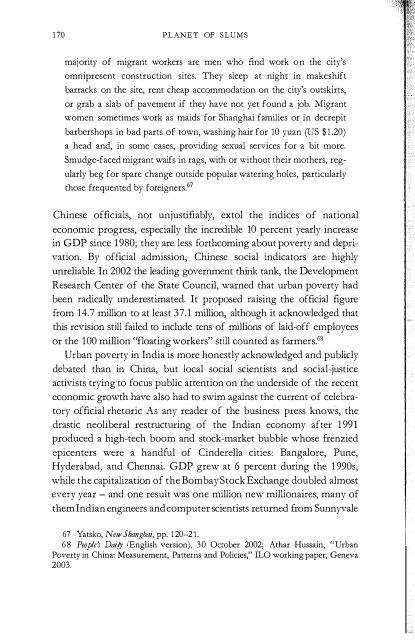Untitled - Rebel Studies Library
Untitled - Rebel Studies Library
Untitled - Rebel Studies Library
Create successful ePaper yourself
Turn your PDF publications into a flip-book with our unique Google optimized e-Paper software.
170 PLANET OF SLUMS<br />
majority of migrant workers are men who find work on the city's<br />
omnipresent construction sites. They sleep at night in makeshift<br />
barracks on the site, rent cheap accommodation on the city's outskirts,<br />
or grab a slab of pavement if they have not yet found a job. Migrant<br />
women sometimes work as maids for Shanghai families or in decrepit<br />
barbershops in bad parts of town, washing hair for 10 yuan (US $1.20)<br />
a head and, in some cases, providing sexual services for a bit more.<br />
Smudge-faced migrant waifs in rags, with or without their mothers, reg<br />
ularly beg for spare change outside popular watering holes, particularly<br />
those frequented by foreigners.67<br />
Chinese officials, not unjustifiably, extol the indices of national<br />
economic progress, especially the incredible 10 percent yearly increase<br />
in GDP since 1980; they are less forthcoming about poverty and deprivation.<br />
By official admission, Chinese social indicators are highly<br />
unreliable. In 2002 the leading government think tank, the Development<br />
Research Center of the State Council, warned that urban poverty had<br />
been radically underestimated. It proposed raising the official figure<br />
from 14.7 million to at least 37.1 million, although it acknowledged that<br />
this revision still failed to include tens of millions of laid-off employees<br />
or the 100 million "floating workers" still counted as farmers.68<br />
Urban poverty in India is more honestly acknowledged and publicly<br />
debated than in China, but local social scientists and social-justice<br />
activists trying to focus public attention on the underside of the recent<br />
economic growth have also had to swim against the current of celebratory<br />
official rhetoric As any reader of the business press knows, the<br />
drastic neoliberal restructuring of the Indian economy after 1991<br />
produced a high-tech boom and stock-market bubble whose frenzied<br />
epicenters were a handful of Cinderella cities: Bangalore, Pune,<br />
Hyderabad, and Chennai. GDP grew at 6 percent during the 1990s,<br />
while the capitalization of the Bombay Stock Exchange doubled almost<br />
every year - and one result was one million new millionaires, many of<br />
them Indian engineers and computer scientists returned from Sunnyvale<br />
67 Yatsko, Nelv Shanghai, pp. 120-21.<br />
68 People Daily (English version), 30 October 2002; Athar Hussain, "Urban<br />
Poverty in China: Measurement, Patterns and Policies," ILO working paper, Geneva<br />
2003.<br />
SA PING THE THIRD WORLD 171<br />
and Redmond. Less publicized, however, was the accompanying<br />
growth in poverty: India gained 56 million more paupers in the course<br />
of the "boom." Indeed, as Jeremy Seabrook underlines, the early 1990s<br />
may have been "the worst time for the poor since Independence," as<br />
deregulated food grain prices soared 58 percent between 1991 and<br />
1994.69<br />
Growth has been stupendously lopsided, with enormous speculative<br />
investment in the information technology sector leaving agriculture to<br />
stagnate and infrastructure to decay. Rather than taxing new millionaires,<br />
the neoliberal Janata government financed itself with the massive<br />
privatization of state industry, thanks to which Enron now sells electricity<br />
near Bombay at three times the rate of the public utility.<br />
Neoliberal policies, like those in China, have wreaked havoc in the neglected<br />
Indian countryside, where three quarters of households lack<br />
access to sanitation and unpolluted drinking water, and the poor shout<br />
futilely for "Bijli, Sadaak, Paani" ("Electricity, Roads, and Water"). As<br />
Praful Bidwai reported in the Arian Times in 2000:<br />
Infant mortality rates are rising even in states like Kerala and<br />
Maharashtra, which have relatively good social indicators .... The gov<br />
ernment is cutting spending on rural development, including agricultural<br />
programs, and rural employment and anti-poverty schemes, as well as on<br />
health, drinking water supply, education and sanitation. Income growth<br />
in the rural areas, where 70 percent of Indians live, averaged 3.1 in the<br />
1980s. It has sharply declined to 1.8 percent. Real wages of rural workers<br />
decreased last year by more than 2 percent.7 0<br />
While the urban middle classes indulge their new tastes for Californiastyle<br />
tract homes and health clubs, the defeated rural poor have been<br />
killing themselves in droves. In Andhra Pradesh alone, wrote journalist<br />
Edward Luce in July 2004, "500 of its farmers have committed suicide<br />
this year alone, often by drinking the pesticide that was purchased with<br />
debts they could not repay."71 Increased despair in the countryside, in<br />
69 Seabrook, In the Cities f the South, p. 63.<br />
70 Praful Bidwai, "India's Bubble Economy Booms as Poverty Grows," Asia<br />
Times, 17 March 2000.<br />
71 Financial Times, 24/25 July 2004.


